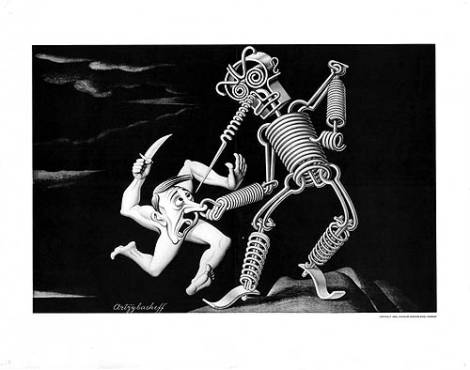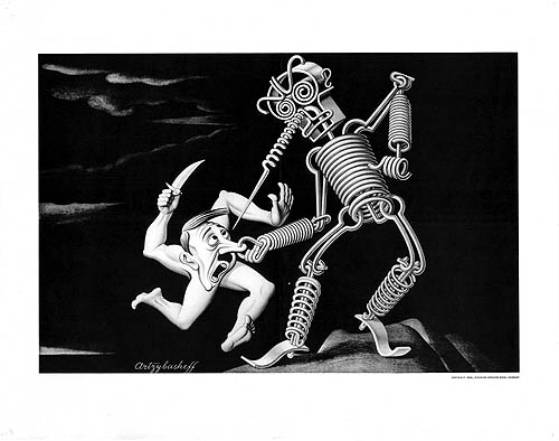 |
"Artzy" Art during World War II
Lesson #1
Introduction and Investigation of an ‘Artzy’ Work of Art!

(Above Image Provided by The University of North Texas Library.)
Description:
This
lesson introduces an image by the Artist Artzybasheff. The students are engaged
in an analysis of the image through discussion and brainstorming
Subject:
Fine Arts, Social Sciences
Duration:
30-45 min
Grade
Levels: 8-12
Standards:
TX-110.42.11.F
TSIET..recognize and interpret important symbols.
TX-110.59.4.I
TSIET... recognize literal and symbolic meanings, universal themes, or
unique aspects of the text.
TX-113.24.a.4.b.8.24.D
TSIET...
analyze the contributions of people of various racial, ethnic, and religious
groups to our national identity.
TX-113.24.a.4.b.8.27.B
TSIET...
analyze the relationship between fine arts and
continuity
and change in the American way of life.
TX-113.24.a.4.b.8.30.B
TSIET...
analyze information by sequencing, categorizing, identifying cause-and-effect
relationships, comparing, contrasting, finding the main idea, summarizing,
making generalizations and predictions, and drawing inferences and conclusions.
TX-113.24.a.4.b.8.30.C
TSIET...
organize and interpret information from outlines, reports, databases, and
visuals including graphs, charts, timelines, and maps.
TX-113.33.b.c.26.C
TSIET... interpret and create databases, research outlines,
bibliographies, and visuals including graphs, charts, timelines, and maps.
TX-113.52.c.1
The student will investigate, independently or collaboratively, a
problem, issue, or concern within a selected profession or discipline.
TX-117.38.b.1
Four basic strands--perception, creative expression/performance,
historical and cultural heritage, and critical evaluation--provide broad,
unifying structures for organizing the knowledge and skills students are
expected to acquire. Students rely on their perceptions of the environment,
developed through increasing visual awareness and sensitivity to surroundings,
memory, imagination, and life experiences, as a source for creating artworks.
They express their thoughts and ideas creatively, while challenging their
imagination, fostering reflective thinking, and developing disciplined effort
and problem-solving skills.
TX-117.38.b.2
By analyzing artistic styles and historical periods students develop
respect for the traditions and contributions of diverse cultures. Students
respond to and analyze artworks, thus contributing to the development of
lifelong skills of making informed judgments and evaluations.
TX-117.38.c.8.1
The student develops and organizes ideas from the environment.
TX-117.38.c.8.3.B
TSIET... identify cultural ideas expressed in artworks relating to
social, political, and environmental themes.
TX-117.54.c.1.B
TSIET... analyze visual qualities to express the meaning of images and
symbols, using precise art vocabulary.
Resources:
At
this point it is not necessary to discuss specifics about the artist and the
image. This is a brainstorming
session. This is a time to form
hypothesis about the image. This is
a time to ask questions about the artwork and investigate its content.
Background information about the artist and his work is in the final
lesson of this unit. At that time
it is appropriate for the students to include that information in their personal
databases, and use it in conjunction with information gained in the other
lessons incorporated in this unit to reanalyze the image.
I feel that providing background information about the artist and the
artwork at this point would skew teacher initiated questions about the image.
However, I do feel it is important that the students know that this is a
poster. This could be a key piece
of information in regard to forming hypotheses about content.
·
The Image
(Provided by The University of North Texas Library.)
Untitled poster by Boris Artzybasheff.

Vocabulary:
Distorted
To twist out of a proper or natural relation of parts; misshape. To give a false or misleading account of; misrepresent.
{Source: The
American Heritage® Dictionary of the English Language, Fourth Edition Copyright
© 2000 by Houghton Mifflin Company.
– Dictonary.com}
A visible sign or representation of an idea; anything which suggests an idea or quality, or another thing, as by resemblance or by convention; an emblem; a representation; a type; a figure; as, the lion is the symbol of courage; the lamb is the symbol of meekness or patience.
{Source:
Webster’s Revised Unabridged Dictionary. 1996, 1998, MICRA, Inc. –
Dictionary.com}
Realistic
1.Tending to or expressing an awareness of things as they really are. 2.Of or relating to the representation of objects, actions, or social conditions as they actually are.
{Source: The
American Heritage® Dictionary of the English Language, Fourth Edition
Copyright © 2000 by Houghton Mifflin Company.
– Dictionary.com}
Brainstorm
To consider or investigate.
{Source: The
American Heritage® Dictionary of the English Language, Fourth Edition Copyright
© 2000 by Houghton Mifflin Company. –
Dictionary.com}
Goal:
The goal of this lesson is to get students to look deeper at a piece of artwork. To investigate clues that may or may not be present in the artwork about where, when, and why the artwork was created. This lesson should stimulate the student’s interest in when, where, who, why, and how the artwork was created. This unit of instruction is geared to teach the students that there is a give and take relationship between art, and the culture and time period in which it was created. This lesson is crucial in getting students to think about a piece of artwork as a primary source.
Objectives:
·
The
students will think critically and contribute to a recorded brainstorming
activity about an artwork by Boris Artzybasheff.
·
The
students will form hypotheses about the image and record them in a brainstorming
activity.
Motivation:
Simply hang the image many places in the room and do not mention it. The students will be curious about the image and ask the teacher about the image. The image is very eye-catching and interesting. Once conversation is initiated by the students about the image pass out more copies of the image so all students have access to the image. (Maybe one 8 x 10 copy per 2-3 students.) At this point move onto the procedure portion of the lesson.
Procedure:
1. Allow time for the students to talk to each other and look at the image. (5-6 minutes) Then pass out the questionnaire about the artwork. (One for each student.) This will help stimulate thought about the artwork. Give the students about 10-20 minutes to work on the questionnaire and allow them to work in groups of 2-3 students. Make sure each group has a copy of the artwork. (The questionnaire is attached to the lesson on a separate sheet.)
2. At this point start asking the students questions about the image. Record their answers on a large tablet or large sheet of butcher paper. (Take good notes because you, the teacher, are going to refer to these notes in all of the lessons incorporated in this unit.) The following are some questions you could ask.
What
does the image show?
What
is in the image?
What
is larger in the image?
What
is smaller in the image?
Describe
the picture.
Where
is it? Describe the scene.
How
does it look?
Does
it look realistic?
What
colors did the artist use?
Do
the characters of the image look realistic?
What
are they made of?
What
is happening in the picture?
What
is the mood of the picture?
What
is in the picture?
Do
you see any symbols in the picture?
(A
symbol is anything that stands for or represents some other thing, person or
idea.)
Has the artist made anything look funny?
Has the artist made anything look ugly?
Has the artist made anything look mean?
Has the artist made anything look distorted?
Above are a few suggested questions to ask. Many times discussions such as this will lead to questions that could not be anticipated.
3. After students have brainstormed about the attributes of the artwork now have them use the information they have collect so far to form some hypotheses about the artwork. Record their answers on a large tablet or large sheet of butcher paper. (Take good notes because you, the teacher, are going to refer to these notes in all of the lessons incorporated in this unit.) The following are some questions you could ask.
Do
you think the artist was conveying any specific ideas?
What?
If
so, how is he conveying those ideas?
Is
the artist using symbols to convey ideas?
Is
the artist comparing things in this image?
What?
When do you think this artwork was created? Why? What clues do you see?
Above are a few suggested questions to ask. Many times discussions such as this will lead to questions that could not be anticipated.
4. The last question of the questionnaire asks students to add any observations they would like to add after the brainstorming session. Ask the students to complete this last question and turn in their questionnaire for you to review. Hold on to these because you, the teacher, will use these again in the final lesson of this unit.
5. Hopefully the students have observed that there are some obvious references to Hitler and World War II in this work of art. And that the artwork is using anthropomorphic figures to convey ideas some of which are in metaphoric form. The rest of the lessons deal with investigating different aspects of this image and many of these aspects were probably discussed in this lesson.
Assessment:
The completed questionnaire and participation in the brainstorming activity will indicate the level at which the student critically thought about the artwork by Boris Artzybasheff. (Refer to rubric at the end of this unit.)
Materials:
· Questionnaire – one copy per group. (A copy of the questionnaire is attached to this lesson.)
· 10-15 copies of the Boris Artzybasheff image.
· A large tablet of paper or a large piece of butcher paper.
Background:
At
this point it is not necessary to discuss specifics about the artist and the
image. This is a brainstorming
session. This is a time to form
hypothesis about the image. This is
a time to ask questions about the artwork and investigate its content.
Background information about the artist and his work is in the final
lesson of this unit. At that time
it is appropriate for the students to include that information in their personal
databases, and use it in conjunction with information gained in the other
lessons incorporated in this unit to reanalyze the image.
I feel that providing background information about the artist and the
artwork at this point would skew teacher initiated questions about the image.
However, I do feel it is important that the students know that this is a
poster. This could be a key piece
of information in regard to forming hypotheses about content.
Lesson by Sandra S. Newton
Investigating
a Work of Art
Questionnaire
Name:______________________
Class Period:_____ Date:___________
1.
Describe
the picture.
2.
What
is happening in the picture?
3.
Do the characters of the image look realistic?
4.
Do
you see any symbols in the picture?
5.
Do
you think the artist was conveying any specific ideas?
What?
6.
Now
that we have brainstormed as a class and deeply analyzed this artwork, add new
thought you have about the artwork.